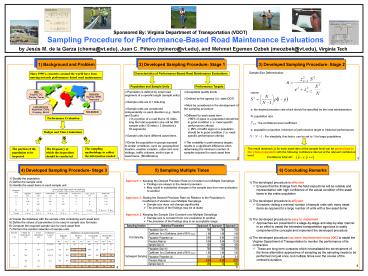Sampling Procedure for Performance-Based Road Maintenance Evaluations - PowerPoint PPT Presentation
1 / 1
Title:
Sampling Procedure for Performance-Based Road Maintenance Evaluations
Description:
Sponsored By: Virginia Department of Transportation (VDOT) Sampling Procedure for Performance-Based Road Maintenance Evaluations by Jes s M. de la Garza (chema_at_vt ... – PowerPoint PPT presentation
Number of Views:118
Avg rating:3.0/5.0
Title: Sampling Procedure for Performance-Based Road Maintenance Evaluations
1
Sponsored By Virginia Department of
Transportation (VDOT)
Sampling Procedure for Performance-Based Road
Maintenance Evaluations
by Jesús M. de la Garza (chema_at_vt.edu), Juan C.
Piñero (rpinero_at_vt.edu), and Mehmet Egemen Ozbek
(meozbek_at_vt.edu), Virginia Tech
Sample Size Determination
Characteristics of Performance-Based Road
Maintenance Evaluations
Since 1990s, countries around the world have
been moving towards performance-based road
maintenance
Population and Sample Units
Performance Targets
- Population is defined by small road segments of a
specific length (sample units) - Sample units are 0.1 mile-long
- Sample units are considered independently on each
direction (e.g., North and South) - In a portion of a road that is 10 miles long the
total population size will be 200 sample units
(10 miles x 2 directions x 10 segments) - Sample units have different asset items
- Divide the population in groups exposed to
similar conditions, such as geographical
location, weather variation, urban and rural
settings, traffic volumes, and/or type of asset
items. (Stratification)
- Acceptable quality levels
- Defined by the agency (i.e. state DOT)
- Must be considered in the development of the
sampling procedure - Different for each asset item
- 90 of pipes in a population should be in good
condition ( i.e. meet specific performance
criteria) - 95 of traffic signs in a population should be
in good condition ( i.e. meet specific
performance criteria) - The variability in performance targets results in
a significant difference when determining the
minimum number of samples required for each asset
item
Performance Evaluation
Budget and Time Limitations
The sampling methodology to collect the
information needed
The portion of the population to be inspected
The frequency at which the inspections should be
conducted
The result obtained ( ) for each asset item at
the sample level can be generalized to the whole
population with the following confidence interval
at the relevant confidence level
3
1
2
- Stratify the population
- Define the sample units
- Identify the asset items in each sample unit
- Create the database with the sample units
containing each asset item - Define the values of parameters to be used in
sample size formulas - Compute the required sample size for each asset
item - Perform the random selection of sample units
- Approach 1 Keeping the Desired Precision Rate
(e) Constant over Multiple Samplings - Findings are always in the desired precision
- May result in substantial changes in the sample
size from one evaluation to another - Approach 2 Stating the Desired Precision Rate
(e) Relative to the Populations Coefficient
of Variation over Multiple Samplings - Sample size does not change significantly
- The precision of the findings may be at stake
- Approach 3 Keeping the Sample Size Constant over
Multiple Samplings - Sample size is constant from one evaluation to
another - The precision of the findings stay in an
acceptable range
- The developed procedure is effective
- Ensures that the findings from the field
inspections will be reliable and representative
with high confidence of the actual condition of
the asset items in the entire population - The developed procedure is efficient
- Envisions visiting a minimal number of sample
units with many asset items as opposed to a large
number of units with a few asset items - The developed procedure is easy to implement
- Approaches are presented in a stage-by-stage and
step-by-step manner in an effort to assist the
interested transportation agencies to easily
comprehend the concepts and implement the
developed procedure - The developed procedure has been implemented
since 2002 to assist the Virginia Department of
Transportation to monitor the performance of its
contractors - These are long term contracts which necessitated
the development of the three alternative
approaches of sampling as the sampling needs to
be performed not just once, but multiple times
over the course of the contracts duration
6
4
5































